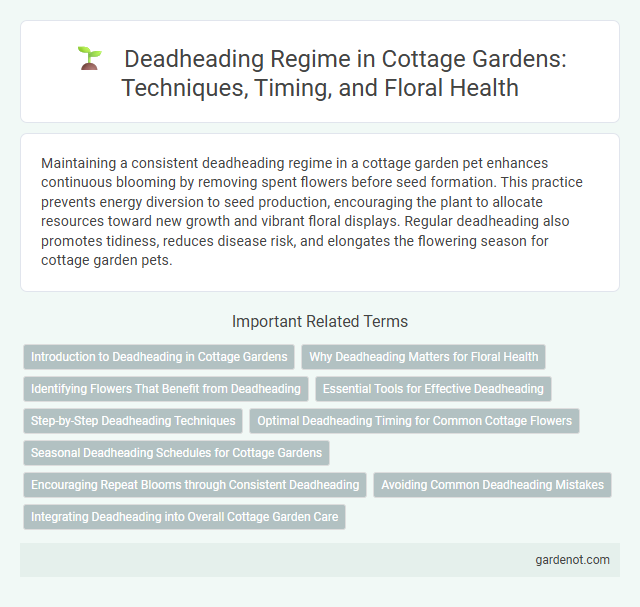Maintaining a consistent deadheading regime in a cottage garden pet enhances continuous blooming by removing spent flowers before seed formation. This practice prevents energy diversion to seed production, encouraging the plant to allocate resources toward new growth and vibrant floral displays. Regular deadheading also promotes tidiness, reduces disease risk, and elongates the flowering season for cottage garden pets.
Introduction to Deadheading in Cottage Gardens
Deadheading in cottage gardens involves the regular removal of spent flowers to encourage continuous blooming and maintain plant health. This practice helps redirect the plant's energy from seed production to new flower growth, enhancing the garden's vibrant and lush appearance. Implementing a consistent deadheading regime supports the prolonged flowering period typical of traditional cottage garden plants such as roses, hollyhocks, and foxgloves.
Why Deadheading Matters for Floral Health
Deadheading is essential for prolonging the blooming period and enhancing the overall vitality of cottage garden flowers. Removing spent blooms prevents seed formation, allowing the plant to redirect energy toward new growth and more vibrant blossoms. This practice also reduces disease risk by eliminating decaying petals that can harbor pests and fungal infections.
Identifying Flowers That Benefit from Deadheading
Deadheading extends the blooming period of popular cottage garden plants like roses, dahlias, and marigolds by removing spent flowers before seed formation. Perennials such as coneflowers and salvias also respond well to deadheading, promoting continuous floral displays. Identifying these species and routinely pinching off faded blooms supports vibrant, prolonged garden color and healthy plant growth.
Essential Tools for Effective Deadheading
Essential tools for effective deadheading in a cottage garden include sharp pruning shears, hand scissors, and a garden knife, ensuring clean cuts that promote healthy regrowth. Gloves protect hands from thorns and irritants during the removal of spent flowers. A small bucket or garden waste bag is useful for collecting debris, maintaining tidy borders and pathways.
Step-by-Step Deadheading Techniques
Deadheading in a cottage garden involves systematically removing spent flowers to promote continuous blooming and maintain plant health. Begin by identifying faded blossoms, then use clean, sharp scissors or garden shears to cut just above the first set of healthy leaves or a lateral bud. Regularly inspect plants every 7-10 days during the flowering season to optimize growth and enhance garden aesthetics.
Optimal Deadheading Timing for Common Cottage Flowers
Deadheading roses, lavender, and dahlias in a cottage garden is most effective when done early morning to prevent stress and promote vigorous blooming. Removing spent blooms just as they begin to fade encourages continuous flower production and reduces disease risk. Timely deadheading during peak growing seasons maximizes flower lifespan and garden aesthetics.
Seasonal Deadheading Schedules for Cottage Gardens
Seasonal deadheading schedules for cottage gardens enhance prolonged blooming by targeting specific flowering periods, such as deadheading roses in late spring through summer and clearing spent blooms of perennials like coneflowers during mid to late summer. Regular removal of faded blossoms from annuals like marigolds and petunias throughout the growing season encourages continuous flowering and prevents seed setting. Implementing a consistent deadheading routine tailored to each plant's bloom cycle maintains garden health, promotes vibrant growth, and sustains the classic abundance characteristic of cottage gardens.
Encouraging Repeat Blooms through Consistent Deadheading
Consistent deadheading in a cottage garden promotes repeat blooms by removing spent flowers, which redirects the plant's energy into producing new buds rather than seed formation. This practice enhances floral display longevity, especially in species like roses, dahlias, and zinnias, known for their prolific reblooming potential. Regularly cutting back faded blooms every few days ensures continuous flowering, contributing to a vibrant, flourishing garden throughout the growing season.
Avoiding Common Deadheading Mistakes
Maintaining a consistent deadheading regime in a cottage garden prevents spent blooms from draining plant energy and encourages prolonged flowering cycles. Avoiding common deadheading mistakes such as cutting too close to the main stem or removing healthy foliage preserves plant health and promotes vigorous growth. Using clean, sharp tools minimizes damage and reduces the risk of disease, ensuring a thriving and aesthetically pleasing garden throughout the season.
Integrating Deadheading into Overall Cottage Garden Care
Regular deadheading of cottage garden blooms enhances continuous flowering and prevents seed formation that can drain plant energy. Incorporating deadheading into the overall care routine supports plant health and encourages vigorous growth, especially for species like roses, lavender, and foxgloves. Timely removal of spent flowers aligns with watering, pruning, and fertilizing schedules, maintaining the garden's vibrant and lush appearance throughout the growing season.
Deadheading regime Infographic

 gardenot.com
gardenot.com